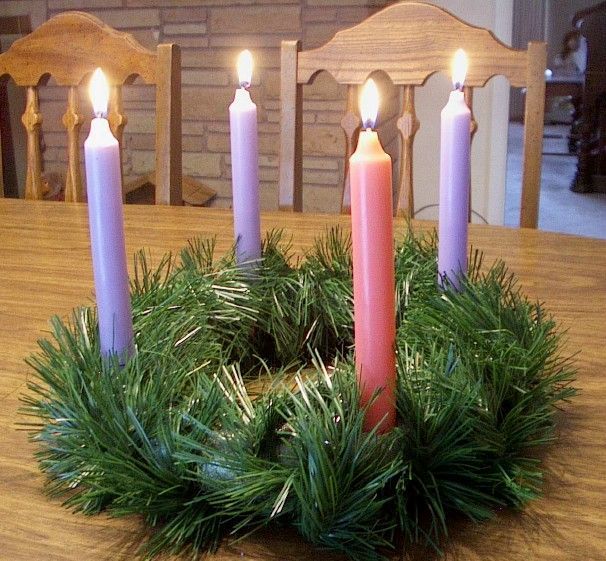I was asked recently about the meaning of the Advent wreath. I had to search my seminary memory banks to answer that question. In essence, the Advent Wreath is about bringing light into a dark world, but the meaning is deeper than that. I was also surprised to learn that the Advent Wreath tradition only dates to the 17th century.
According to research conducted by Mary Jane Haemig, Professor of Church History at Luther Seminary of St. Paul, Minnesota, the modern-day Advent Wreath was started by Johann Hinrich Wichern, a Protestant Pastor and missionary to the urban poor. In 1839, Pastor Wichern created a large wooden ring from a cartwheel and placed twenty red and four small white candles around the circle. Each weekday, and Saturday a red candle would be lit, and on Sundays, a white one. The popularity of this ring grew into the smaller version that we are familiar with today. During the 1920s, Roman Catholics in German began to adopt the wreath’s use during the Advent season, and its popularity spread to North America in the 1930s.
So, what is the symbolism of the Advent Wreath?
Advent wreaths a circular indicating the endless love of God for all of creation. Most Advent Wreaths are made from evergreen leaves or branches representing the eternal life brought by Jesus Christ. As previously mentioned, the candles on the Advent Wreath represent the light of Christ coming into the world, although each candle has a meaning of its own.
Each candle of the Advent Wreath represents one of the Christian concepts of hope, peace, joy, and love. Many Advent Wreath will also have a larger white candle in the center that lit on Christmas Eve or Christmas Day to symbolize the Good News of the birth of Jesus Christ. The candle is white because this is the Liturgical color for the celebration of feast days.
Three of the four candles on the Advent Wreath are purple. Purple is the traditional color for the Advent Season, which represents the original penitential nature of Advent. The fourth candle is pink or rose and is lit on the third Sunday, Gaudete Sunday, from the Latin word meaning “rejoice ye.” The theme of the third Sunday is joy, so the penitential nature of the season is paused as we recall the joy of the Christ Child’s coming.
I encourage all of you to begin or continue the tradition of lighting the Advent Wreath in your homes. The wreath does not have to be fancy or even store-bought. It can be made from simple items from around your home and yard. Whatever you chose to use, a blessing of the wreath is appropriate. Here is one I like to use.
Lord our God, we praise you for your Son, Jesus Christ: he is Emmanuel, the hope of the peoples, he is the wisdom that teaches and guides us, he is the Savior of every nation. Lord God, let your blessing come upon us as we light the candles of this wreath. May the wreath and its light be a sign of Christ’s promise to bring us salvation. May he come quickly and not delay. We ask this through Christ our Lord. Amen.
The blessing may conclude with a verse from “O Come, O Come, Emmanuel”:
O come, desire of nations, bind in one the hearts of humankind; bid ev’ry sad division cease and be thyself our Prince of peace. Rejoice! Rejoice! Emmanuel shall come to thee, O Israel.
—From Catholic Household Blessings & Prayers

